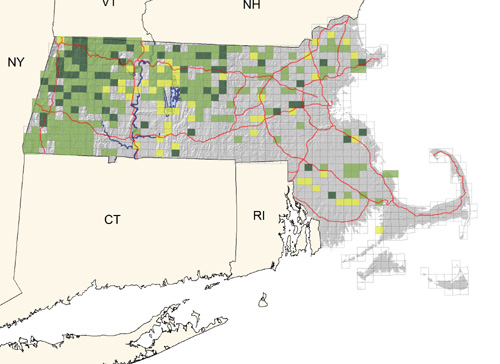Breeding Bird Atlases (BBA)
Find a Bird - BBA1
Breeding Bird Atlas 1 Species Accounts
White-throated Sparrow
Zonotrichia albicollis
Egg Dates
May 25 to June 7
Number of Broods
one; may renest if first attempt fails.

The White-throated Sparrow is a fairly common nesting species in the higher elevations of the western portion of the state from Berkshire County east to Worcester County. Summer residents are markedly uncommon and local in the eastern half of the state and are absent from Cape Cod and the Islands.
The peak of the White-throated Sparrow migration occurs between mid-April and mid-May, when this species is one of the most ubiquitous and abundant of spring migrants. Residents quickly sort themselves out from the northbound migrants as they gravitate to their favored habitats. In the central and western parts of the state, White-throated Sparrows occupy a wide range of semiopen scrub and thicket habitats. They are most often found on the edges of lowland bogs and in slash areas on coniferous slopes, the scrubby growth of exposed hillsides and summits, and power-line clearings. The relatively rare residents of eastern Massachusetts occur in the cool Red Maple and Atlantic White Cedar swamps.
The Old Sam Peabody, Peabody, Peabody vocalization of the White-throated Sparrow is perhaps one of the better known bird songs. According to a Federation of Ontario Naturalists recording by Borror and Gunn, however, this well-known phrase is not the commonest of the 15 different song patterns attributed to this species. The most commonly given song can be represented as Poor Peabody, Sam Peabody, Peabody, Peabody. Most of the variations are combinations of sustained single notes and triplets. Call notes include a high tseet as well as a louder chip face or chink.
Males claim and defend territories, and, in areas where the species is common, this may involve many chases and fights early in the season. An intriguing situation with the White-throated Sparrow is the fact that both sexes have two color morphs: one with white crown stripes and the other with tan stripes. Studies have revealed that there are behavioral differences for each morph. The more aggressive white-striped males tend to pair with the tan-striped females, leaving the white-striped females to mate with the tan-striped males.
The White-throated Sparrow builds its nest on or close to the ground in a slight depression, hummock, or brush pile. Four Worcester County nests were located as follows: 2 beneath White Pine seedlings in a selectively logged forest, 1 among Canada Mayflower in a wood edge, 1 in a sapling clump in an old field (Meservey). The young fledge at between 7 and 12 days of age. Fledglings have been observed in Worcester County on June 17, June 19, and June 22 (Meservey). Normally, a single brood is raised each season, with the female remaining with the fledged young even after they have left the nesting territory. Many pairs will attempt a second nesting if the first attempt fails.
Adults have a complete molt after the breeding season, and the young then attain winter plumage. Groups of migrant White-throated Sparrows are noted throughout the state from mid-September to early November. These flocks are encountered frequently on the edges of weed fields, along roadsides, and in thickets. After mid-November, wintering flocks of White-throated Sparrows can be found in numbers that vary markedly from year to year, most commonly along the coast but also increasingly inland, perhaps due to the recent proliferation of winter bird feeding. The main wintering grounds are in the southern states.
Map Legend and Data Summary
Atlas 1 data collected from 1975-1979


Note: common in hill country in coniferous and mixed woodlands, especially where it has been recently logged; very uncommon and local eastward
Richard K. Walton



